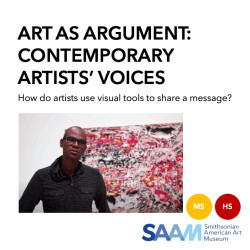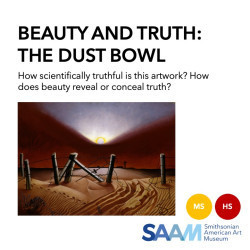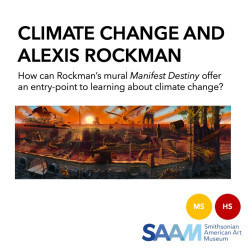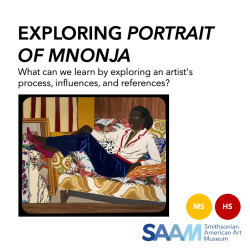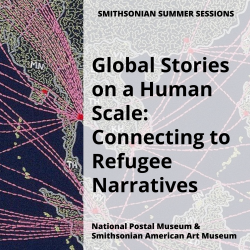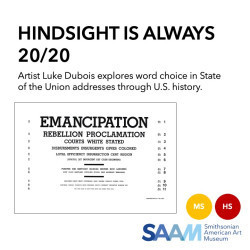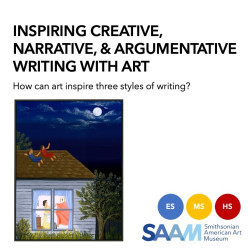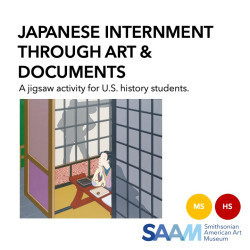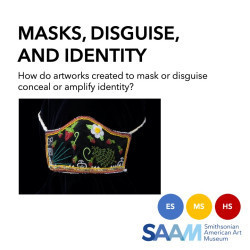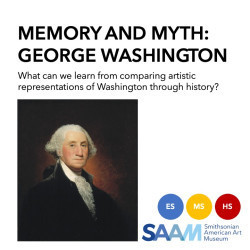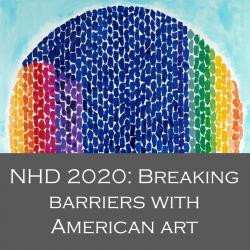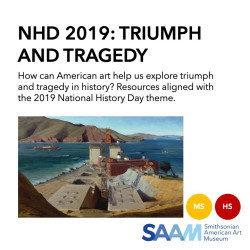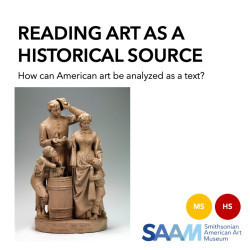Phoebe Hillemann
Teacher Institutes Educator
Smithsonian American Art Museum
As the Teacher Institutes Educator at the Smithsonian American Art Museum, I organize our week-long summer institutes for middle and high school English and social studies teachers: http://americanart.si.edu/institutes. I'm interested in interdisciplinary thinking, arts integration, and the power of dialogue in learning spaces.
Phoebe Hillemann's collections
Art as Argument: Contemporary Artists' Voices
<p>This collection explores the ways in which four American artists have used visual tools to share a message. In <em>Amendment #8</em>, Mark Bradford uses his layered paper and mixed media technique to challenge the viewer to consider how we are living up to the ideals of our founding documents. In <em>Portrait of Mnonja</em>, Mickalene Thomas references the art historical canon to address African American representation in museums. In <em>Life Magazine, April 19, 1968</em>, Alfredo Jaar manipulates a historical photograph to make visible the racial disparities it contains. And with her installation <em>Folding the Chesapeake</em>, Maya Lin begs us to see the critical importance of caring for the waterways around us. </p>
<p>Created for an April 16, 2018 webinar with Montana teachers.</p>
 Phoebe Hillemann
Phoebe Hillemann
12
Art as Argument: Dust Bowl to Climate Change
<p>How have American artists used visuals to bring attention to the pressing issues of their time? Compare and contrast a 1930s painting about the Dust Bowl with one addressing climate change made seventy years later, interpreting them in context to discover continuity and change over time. </p>
<p>Possible thinking questions for students to use with one or both paintings:</p>
<p></p>
<ul><li>Are these artworks primary sources? Does your answer depend on the context in which they are used?</li><li>What is "truthful" about these artworks? How might we use other sources to corroborate or check their truthfulness?</li><li>What do you think are the most effective media for making a compelling argument? Why? Student might consider speeches, photographs, newspaper op-eds, data visualizations like charts and graphs, videos/films, music, and visual art.</li></ul><p>Resources compiled for a March 2020 National Council for History Education (NCHE) conference session.<br /></p><p></p>
 Phoebe Hillemann
Phoebe Hillemann
11
Beauty and Truth: The Dust Bowl
<p>This collection explores Alexandre Hogue's 1933 painting <em>Dust Bowl</em> through a global thinking routine called "Beauty and Truth." Supporting materials help build historical and scientific context. </p>
<p><em>“Some may feel that in these paintings . . . I may have chosen an unpleasant subject, but after all the [drought] is most unpleasant. To record its beautiful moments without its tragedy would be false indeed. At one and the same time the [drought] is beautiful in its effects and terrifying in its results. The former shows peace on the surface but the latter reveals tragedy underneath. Tragedy as I have used it is simply visual psychology, which is beautiful in a terrifying way.” -Alexandre Hogue</em></p>
<p><br /></p>
 Phoebe Hillemann
Phoebe Hillemann
12
Climate Change and Alexis Rockman's Manifest Destiny
<p>In preparing to paint his large-scale mural, <em>Manifest Destiny</em>, a commission for the Brooklyn Museum's re-opening in 2004, Alexis Rockman consulted with climate change experts to imagine what Brooklyn might look like several centuries in the future when the glaciers have melted and sea levels have risen. </p><p>Teachers can use this painting as a starting point to discussing the issue of climate change, understanding what's at risk, and exploring mitigation strategies coastal cities might take to prevent an outcome like the one Rockman predicts.</p>
 Phoebe Hillemann
Phoebe Hillemann
6
Cultural Imagery and Stereotypes: The American Experience in the Classroom
<p>This collection focuses on two works that deal with the issues of nationality, identity and the assimilation of cultures. Mel Casas's pun-laced <em>Humanscape 62</em> combines elements familiar to many Americans: brownie desserts and a young Girl Scout (a Brownie), with traditional Mexican imagery. This pop art style-blend illustrates the Chicano experience to American culture and creates a push and pull narrative about Latino identity. Similarly, Roger Shimomura, an American-born artist of Japanese descent, contemplates repressed emotions from the time he and his family spent in World War II-era Japanese internment camps, following the attack on Pearl Harbor.</p>
<p>#APA2018</p>
<p><a href="http://americanexperience.si.edu/historical-eras/contemporary-united-states/pair-humanscape-diary-december-12/">http://americanexperience.si.edu/historical-eras/c...</a> </p>
 Phoebe Hillemann
Phoebe Hillemann
14
Do Ho Suh: Almost Home
<p>Do Ho Suh’s immersive architectural installations—unexpectedly crafted with ethereal fabric—are spaces that are at once deeply familiar and profoundly alien. Suh is internationally renowned for his “fabric architecture” sculptures that explore the global nature of contemporary identity as well as memory, migration, and our ideas of home.</p>
<p>Suh was born in Korea and moved to the United States at the age of 29 in 1991, and he currently lives between New York, London, and Seoul. He crafts his works using traditional Korean sewing techniques combined with 3-D modeling and mapping technologies. Suh sees these works as “suitcase homes,” so lightweight and portable they can be installed almost anywhere.<br /></p>
<p>Essential Questions:</p>
<ul><li>What is home?
</li><li>How does perspective-taking help us better understand people, events, or issues?</li><li>How can artwork be used as a provocation for the exercise of higher order thinking and transdisciplinary application of content?</li></ul><p>Created for a program with the National Teachers of the Year on April 30, 2018.</p>
<p>#NTOY18</p><p><em>#visiblethinking</em><br /></p>
 Phoebe Hillemann
Phoebe Hillemann
13
Hindsight is Always 20/20
<p>In <em>Hindsight is Always 20/20</em>, Luke DuBois took the State of the Union addresses from each presidency (up through George W. Bush) and sorted them according to word frequency. The artist then printed the most frequently appearing works as an eye chart for each president, with the more frequently used words in larger type at the top of the chart and the less frequently used words toward the bottom. The traditional eye chart includes sixty-six letters; Luke DuBois’s charts substitute sixty-six words. The lists contain words that are not only important for the issues addressed by each president but also give an impression of how language was used at the time. Each of the forty-one presidencies to have State of the Union addresses at the time DuBois created this series (William Henry Harrison and James Garfield died before they could submit a single message to Congress) has its own eye chart. </p>
<p><em>Multiplicity</em>, 2011</p>
 Phoebe Hillemann
Phoebe Hillemann
42
Inspiring Creative, Narrative, & Argumentative Writing with Art
<p>Explore different styles of writing in response to American art! This digital collection suggests artworks from the Smithsonian American Art Museum to use to inspire creative, narrative, and argumentative writing, along with suggested thinking routines and writing prompts. The categories are fluid -- many artworks can be used successfully for more than one type of writing!<br></p>
 Phoebe Hillemann
Phoebe Hillemann
37
Japanese American Incarceration through Art and Documents
<p>These resources can be used in an activity that introduces a lesson on Japanese American Incarceration during World War II. </p>
<p>1. To begin, show students Roger Shimomura's painting entitled Diary: December 12, 1941. Without providing any background information, use the "Claim, Support, Question" routine to have students make claims about what they think is going on in the artwork, identify visual support for their claims, and share the questions they have about the painting. Document responses in three columns on large chart paper or a whiteboard.</p>
<p>2. Following this initial conversation, share the title, artist's name, and date of the painting. Ask students to consider the date in the title, and discuss what significance this date might have. If they don't figure out that this date was five days after the Japanese bombing of Pearl Harbor, share that information. Share with students that this painting is part of a series Roger Shimomura created based on the wartime diary entries of his grandmother, Toku, who was born in Japan and immigrated to Seattle, Washington in 1912. Along with thousands of other people of Japanese ancestry living on the West Coast during World War II , Toku and her family were forcibly relocated to an incarceration camp after the attack on Pearl Harbor. Roger was a young boy during World War II, and remembers spending his third birthday in the Puyallup Assembly Center on the Washington state fairgrounds, where his family was sent before being transferred to Minidoka Reservation in Idaho for the duration of the war.</p>
<p>3. Jigsaw Activity, Pt. 1. After sharing this context, tell students they will each be receiving a primary source document that relates to the painting in some way. Distribute copies of "Woman at Writing Table," the Superman comic, the Instructions to All Persons of Japanese Ancestry, and Toku Shimomura's diary entries. Divide students into four groups, one per document. Give students time to analyze their document as a group and discuss how it affects their interpretation of the painting.</p>
<p>4. Jigsaw Activity, Pt. 2. Next, create new groups so that each group includes students who received each of the four sources. Ask students to briefly report on their document and what their original group discussed as its possible meaning and relation to Roger Shimomura's painting.</p>
<p>5. Return to the painting as a large group, and discuss how the primary source documents have influenced students' reading of the artwork. </p>
<p>6. Optional additional resource: If time allows, have students watch excerpts from Roger Shimomura's artist talk at the Smithsonian American Art Museum.</p>
<p>#APA2018</p>
<p><em>#visiblethinking</em><br></p>
 Phoebe Hillemann
Phoebe Hillemann
9
Native American Art and Artists
<p>The artworks in this collection were made by artists who identify as Native American. What can we learn from the diversity of media and subject matter? How might these works be used to counter stereotypical narratives about American Indians? </p><p>Created for a March 20, 2018 webinar with Montana teachers.</p>
 Phoebe Hillemann
Phoebe Hillemann
17
NCSS 2019: Teaching for Global Competence through American Art
<p>Resources used during a session at the National Council for the Social Studies (NCSS) annual conference in Austin, TX on November 23, 2019.</p>
<p>Essential Question: How can visual art nurture students' capacities to take informed action as citizens in a complex, interconnected world?</p>
 Phoebe Hillemann
Phoebe Hillemann
8
NHD 2020: Breaking Barriers with American Art
<p>This collection is designed to support teachers and students exploring the 2020 National History Day theme: Breaking Barriers in History. Included in this collection are five prospective topics aligned with the NHD theme, for each of which we have supplied American artworks that could be used as primary source texts and/or inspiration for further research.</p>
<p>How did the invention of photography break down the barrier between ordinary Americans and the battlefield during the Civil War? </p>
<p>What barriers, both geographic and social, did the invention and expansion of the subway break for New Yorkers? </p>
<p>How did James Van Der Zee's Harlem photography studio help a rising middle class African American community break barriers?</p>
<p>How have American Indians overcome barriers to tribal sovereignty, and what barriers still exist?</p>
<p>How did abstract painter Alma Thomas break gender and racial barriers in the art world?</p>
<p>#NHD2020 #NHD #BecauseOfHerStory</p>
 Phoebe Hillemann
Phoebe Hillemann
55

